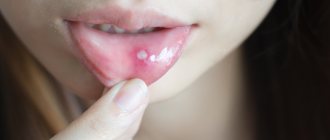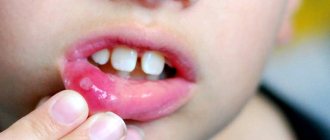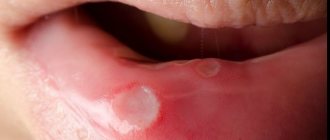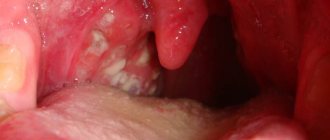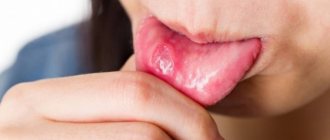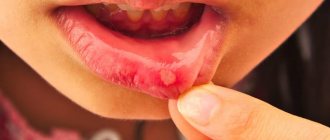Stomatitis in a child is a very common phenomenon caused by an inflammatory process of the oral mucosa, which also occurs in newborns. We can say that raising a child and not knowing what stomatitis looks like in children is almost impossible. Quite often, the symptoms of the disease initially resemble those of a respiratory infection with a characteristic fever, stuffy nose and poor appetite. But after a short time, parents notice the appearance of blisters and ulcers on the gums, cheeks and inner lips, which can be caused by various pathogens. The child behaves anxiously, capriciously, sleeps poorly... Even for an adult, it is very difficult to endure the painful sensations that arise from stomatitis, not to mention children, who cannot always clearly explain what is tormenting them. Parents, of course, are concerned about the question of what causes stomatitis in children and whether the occurrence of such a disease can be prevented. Let's try to understand this thoroughly.
Types of stomatitis
Everyone is more accustomed to saying “stomatitis”, but it would be more correct to say “stomatitis”, since this is a generalizing concept for a whole group of diseases. Depending on the causes of stomatitis, it can be divided into several types, each of which has a number of characteristics.
Viral or herpetic stomatitis in children
One of the most common types of stomatitis in children is caused by the herpes simplex virus. Typically, a child becomes infected through airborne droplets. In addition, the virus is transmitted through dishes, toys, and household items. Most often, herpetic stomatitis appears in a child between the ages of one and four years. The disease begins with a cold, accompanied by lethargy and increased body temperature. Sometimes there is a runny nose and cough. Around the second day, small round or oval erosions of a light yellow color with a bright red border appear on the lips, tongue and inside of the cheeks. Swelling appears, the gums begin to bleed, and the child refuses to eat.
Traumatic stomatitis in a child
The disease is caused by mechanical trauma to the oral cavity. For example, burns from hot food, a too hard nipple, the habit of chewing a pencil. In addition, traumatic stomatitis often occurs in children with malocclusion due to frequent biting of the cheeks and tongue.
Candidal stomatitis
Appears in children under one year of age. The cause is Candida fungi. The main symptom is the appearance of a white coating in the baby’s mouth. It should be noted that this should not be confused with regular flowering after feeding. A cause for concern is if plaque persists and the baby refuses to eat.
Drug or allergic stomatitis in children
Caused by certain allergies or reactions to medications. If this type of disease is suspected, it is necessary to identify and remove the allergen, otherwise there is a risk of unpleasant consequences, including anaphylactic shock.
Each type of stomatitis is characterized by a certain childhood age. Young children often have candidiasis or fungus (thrush). At the age of “I want to know everything” in a child of 3-4 years, stomatitis is usually infectious in nature, when the infection is transmitted through dirty hands or objects. From one to four years, an acute herpetic form of the disease is often observed.
Prevention of stomatitis
To avoid the appearance of stomatitis in adults, it is necessary to maintain oral hygiene, eat well, stop smoking, promptly treat colds and other diseases, prevent dirt from getting on the mucous membrane, and undergo preventive examinations at the dentist to prevent caries and other dental problems.
Learn about other oral diseases
Noma Periodontitis Damage to the oral mucosa (from wearing dentures, piercings, braces, crowns) Periodontitis
Causes of stomatitis in children
In childhood stomatitis, the mucous membrane of the oral cavity is affected: small, white or yellowish, fluid-filled pimples appear on its surface. In some cases, ulcers form.
Stomatitis is predominantly a childhood disease, although it can also occur in adults. The rash affects the inside of the cheeks, tongue and gums. The disease causes a lot of inconvenience: pimples hurt and itch, and their appearance is accompanied by a burning sensation in the mouth.
Among the main reasons for the development of stomatitis are:
- poor oral hygiene;
- mucosal injuries;
- diseases of the gastrointestinal tract;
- burns of the oral cavity;
- pathogenic bacteria that enter the oral cavity with dirty hands, toys, etc.
What are the reasons for stomatitis in children?
Various factors can contribute to the development of stomatitis in a child, for example, insufficient hand and oral hygiene, the habit of gnawing objects found on the floor. It is worth understanding that, unlike adults, the mucous membrane in children is more delicate and vulnerable, and the immune system is not yet strong enough to resist infections. In addition, at an early age, the process of salivation has not yet fully formed. Because of this, the child’s mucous membrane often dries out, cracks appear, into which infection enters and inflammation begins. Other causes of stomatitis include long-term use of medications, neuropsychiatric disorders, lack of proper treatment for ARVI and other diseases, unfavorable living conditions, etc.
Symptoms of stomatitis
Signs of stomatitis in a child have a number of features characteristic of a particular type of disease.
Herpetic stomatitis in children is considered very common and usually manifests itself as follows:
- in the initial stage, the disease is confused with a cold due to increased body temperature, often runny nose and cough;
- the inflammatory process begins abruptly, manifested by headaches and pain in the mouth and muscles due to intoxication of the body;
- submandibular lymph nodes are enlarged and painful;
- feature - the formation of small bubbles filled with liquid.
Upon visual examination, redness of the gum tissue around the teeth, swelling of the mucous membrane and numerous vesicular rashes covered with a yellowish or whitish coating are noted. Candidal stomatitis in children can be clinically acute or mild. In this case, signs of stomatitis in a child appear as follows:
- very rarely an increase in temperature is recorded;
- in the oral cavity there are affected areas covered with a coating of cottage cheese;
- children behave restlessly, are capricious, refuse to eat;
- Locally similar stomatitis in children (or thrush, as it is often called) occurs on the tongue, cheeks, gums and inner lips).
Aphthous stomatitis in children is the most common form of the disease, but also difficult to treat due to the difficulty of identifying the specific pathogen. Similar stomatitis in children, the symptoms of which are more common in schoolchildren than in the younger age group, is characterized by the following symptoms:
- rash of single ulcers (feed) on the mucous membrane (on the cheeks, in the area of the tongue and the inside of the lips);
- Initially, such stomatitis in children in the mouth is manifested by characteristic redness, itching, burning, and an increase in temperature is also noted.
In this case, the ulcers do not look like blisters, but are whitish ulcers with a bright red outline around them. Then the ulcers are usually covered with a cloudy film, which can break through and cause a secondary infection, after which the baby’s condition will only worsen. Parents should know that stomatitis in a child is not a single type of infection with specific symptoms.
Each form of this inflammatory process has its own specific symptoms and causes. That is why, despite a number of individual similar points (temperature during stomatitis in a child, signs of inflammation of the mucous membrane, enlarged lymph nodes), the problem of treating stomatitis in a child is solved differently, taking into account the form of the disease.
Oral care during stomatitis treatment
Local treatment of stomatitis in adults plays an important role in the success of therapy. It is necessary to follow a gentle and low-allergenic diet. Food should be warm and soft, not irritating the mucous membranes. During treatment, you should exclude hard, spicy, sour, and sweet foods from your diet. After every meal you need to rinse your mouth. For this purpose, special remedies for stomatitis (solutions or infusions) can be used, which the doctor will recommend. They have an antiseptic effect and protect the oral cavity from the development of pathogenic bacteria.
An important aspect in the treatment of stomatitis in adults is pain relief, since aphthae and ulcers can cause significant discomfort, interfering with normal eating and talking. In this case, local painkillers such as Cholisal® have worked well. This gel has a local analgesic and anti-inflammatory effect for stomatitis in adults. The antiseptic included in the composition protects the oral cavity from bacteria. The analgesic effect of the gel against stomatitis occurs within 2-3 minutes and lasts from 2 to 8 hours. Such remedies for stomatitis in adults, in combination with the main therapy prescribed by the doctor, help cope with unpleasant sensations in the mouth and speed up the healing process.
Diagnosis of the disease
The pathology of stomatitis is diagnosed by infectious disease specialists, pediatricians, and pediatric dentists. The diagnosis is made on the basis of clinical and epidemiological data.
Based on materials from smears, scrapings, and blood, the following studies are carried out:
- virological;
- bacteriological;
- immunological;
- cytological.
Diagnostics such as polymerase chain reaction and enzyme immunoassay are performed. In some cases, the child has a blood test for the presence of sugar, and a consultation with an endocrinologist, allergist and other specialists is carried out.
Correctly conducted diagnostic examinations will help establish the correct diagnosis and prescribe effective treatment so that the situation does not worsen.
Drugs for the treatment of stomatitis
How to treat stomatitis in adults and children?
In the pharmacy you can find a huge number of drugs that help in the fight against stomatitis, the cause of its occurrence and symptoms.
Most of them are sold without a prescription, so anyone can purchase the drug. In the treatment of stomatitis, an integrated approach is used: it is necessary to influence the cause of the disease, as well as alleviate the severity of symptoms.
Painkillers
If the ulcers interfere with eating and talking, or cause great discomfort for the patient, it is considered advisable to prescribe painkillers for topical use. These include:
- Anestezin is available in tablet form for grinding into powder. It has a local analgesic effect on the mucous membrane in the affected area.
- Hexoral is an effective tablet for resorption in the mouth, helping in the fight against ulcerative lesions of the mucous membrane. They have a double result - the drug has an antibacterial and anesthetic effect.
- Lidocaine Asept is available in the form of a spray, which is convenient for topical use. The drug contains lidocaine and chlorhexidine: they provide a disinfecting and analgesic effect. This spray is preferable for ulcerative stomatitis.
- Lidochlor - this gel relieves pain and has an antibacterial effect on the oral mucosa, relieves inflammation.
Herbal remedies - a decoction of chamomile, calendula, sage, also have some antiseptic properties and have a calming effect on the mucous membrane. They help relieve inflammation and relieve swelling of the affected mucosa.
Antiseptics and anti-inflammatory drugs
These drugs are the basis for the treatment of stomatitis. They are produced in the form of tablets for resorption in the oral cavity, in the form of sprays for irrigation of the mucous membranes, ointments, gels, etc.
- Kamistad - contains chamomile, which provides relief from inflammation and a calming effect. Lidocaine has an analgesic effect on the affected mucous membrane.
- Cholisal is available in gel form. Has an excellent anti-inflammatory and antibacterial effect.
- Stomatidine (hexetidine) is an antiseptic drug widely used in dental practice.
- Cametone – contains essential oils, has an antimicrobial and local anesthetic effect. Sold in pharmacy chains in the form of an aerosol or spray.
Ingalipt and Hexoral sprays are also used for topical use for stomatitis. They prevent the spread of infection in the oral cavity and speed up the onset of recovery.
Special products for the treatment of stomatitis in adults
Depending on the cause of the development of stomatitis - a fungus, a virus or a bacterium, specific medications are selected.
Acyclovir, Zovirax are used to combat herpetic stomatitis; in some cases, it is advisable to use interferons. When treating fungal stomatitis, the doctor may prescribe Mycozon, Levorin, nystatin ointment, etc. Bacterial stomatitis requires the prescription of antibiotics, taking into account the sensitivity of microorganisms.
Drugs that enhance regeneration
In this case, drugs that accelerate the healing process of damaged mucous membranes can help.
- Solcoseryl - this medicine is often used in the practice of a dentist. Available in the form of a paste, which must be applied to the lesions. Solcoseryl helps improve trophic processes and accelerates tissue regeneration;
- Sea buckthorn oil is an excellent natural remedy; it helps accelerate the healing of mouth ulcers;
- Vinylin is an antiseptic balm. The principle of action is to envelop the ulcers and heal them more quickly;
- Proposol spray - the effect of the drug is based on propolis.
In the case of an allergic form of pathology, the first step in treatment is the identification and exclusion of the allergen. Some people may experience an allergic reaction after getting braces or dentures, or when using a new drug. Since ulcers in this form of stomatitis are a symptom of the body’s reaction to an allergen, it is the allergy that must be eliminated first. Antihistamines are used for this purpose. You can take them in the form of tablets or applications to the mucous membrane.
There are contraindications. Specialist consultation is required.
Treatment of stomatitis in children
After a medical diagnosis of stomatitis in children under one year of age, a specialist prescribes highly effective drugs to combat the existing type of disease. Experts recommend that parents, at the first suspicion of stomatitis in a child, increase the amount the child drinks to irrigate the oral mucosa and remove toxins from the body. Clean drinking water without gas, fruit drinks or compotes that are not too sweet or sour; herbal teas are perfect for this. During this period, it is worth refusing to drink the child from concentrated juices and drinks with gas in order to avoid irritation of the mucous membrane.
After this, the specialist begins medical manipulations to cure stomatitis in the child.
Anesthesia
The first step is to numb the mucous membranes so that the child can eat and drink properly and generally reduce the child's stress level. Choline preparations with salicylate or lidocaine are commonly used as pain relievers in children. For this purpose, medications to facilitate teething, for example Kamistad or Dentinox gel, are suitable. Gel products are preferable for children because they are almost instantly absorbed into the mucosal tissue. Prepare with lidocaine in the form of a spray should not be used in children under one year of age - this may lead to bronchospasm.
Direct treatment of stomatitis
After anesthesia, you can begin treating your baby’s stomatitis. Firstly, all rashes and wounds must be treated with a special preparation, depending on the type of disease. Antiviral drugs are used for herpetic stomatitis, antibiotics and antiseptic drugs for bacterial stomatitis, antifungal drugs for candidal stomatitis. Not only the affected area, but also adjacent areas must be treated - this will stop the spread of the pathogenic process.
An important condition for eliminating infection is thorough and timely oral hygiene. The surface of the child's tongue and teeth should be brushed twice a day; experts recommend rinsing the mouth after every meal or drink. For young children, hygiene procedures are carried out using a piece of gauze or a silicone fingertip.
Treatment of allergic stomatitis
If a specialist has identified the presence of allergic stomatitis or severe swelling of the oral cavity is observed, then the drugs Fenistil, Suprastin, Diphenhydramine are used.
Treatment of viral stomatitis
For herpetic stomatitis, antiviral agents should be used in the form of ointments containing acyclovir - Gerpevir, Virolex, Acik, Viferon, oxolinic ointment.
For relapses of viral stomatitis, experts recommend a general strengthening of the immune system with the help of Immunal, Interferon, Viferon in suppositories. The duration of treatment and dosage of the drug is determined by the doctor. Often, medical experts recommend using the drug Cholisal in gel form. Perfectly relieves swelling, inflammation, pain, fever, eliminates pathogenic microflora. The drug does not contain sugar, has no taste and has a light anise aroma. To treat stomatitis in a child under one year old, it is necessary to rub a strip of gelatin preparation no more than 0.5 centimeters long into the palate, gums and inner surface of the cheeks, teeth, 2-3 times a day after brushing the teeth.
Treatment of candidal stomatitis
For candidal stomatitis, the doctor uses antifungal drugs in the form of an ointment, for example, Clotrimazole, Candida, Candizol, and often prescribes soda rinses.
This helps create an alkaline environment in the oral cavity, harmful to pathogenic fungal microflora. Procedures with soda are especially effective in the treatment of candidal stomatitis in children under the age of one year, because at this age most drugs are contraindicated. To treat the oral cavity, you need to dilute a teaspoon of soda in a glass of warm boiled water, then wrap a piece of gauze around a clean finger and wipe the palate, inner surface of the cheeks, gums and sublingual space of the child, periodically dipping your finger into the solution. The procedure should be done after every child eats or drinks. Older children can rinse their mouths with baking soda themselves.
Treatment of aphthous stomatitis
With aphthous stomatitis, the first priority is to unload the affected area and speed up the healing of the poop. An aqueous solution of blue (methylene blue) has long been used for this purpose. It is not recommended to use a blue alcohol solution for this, since the ethyl alcohol in its composition will cause poisoning or burn the baby’s mucous membrane.
Wounds are treated with a blue cotton swab 3-6 times a day.
Treatment of traumatic stomatitis
According to experts, traumatic stomatitis most often occurs in children 1-2 years old. This type of disease is accompanied by bacterial microflora, so the use of medicinal and antiseptic agents will be required. For children under 2 years of age, use Cholisal, Solcoseryl, Actovegin gel, and also wipe the oral cavity with a solution of chlorhexidine or soda.
Treatment of bacterial stomatitis
For the treatment of bacterial stomatitis, drugs such as Tantum Verde, Orasept and Hexoral in the form of a spray, Doctor Theiss and Septolete in the form of lozenges and many others are effective. Experts do not recommend using lozenges to treat children under 6 years of age due to the risk of asphyxia, and sprays are suitable for treating bacterial stomatitis in children over one year of age. Antiseptic rinses and gel preparations with metronidazole are also effective.
Among solutions with an antiseptic effect, the drug Miramistin is especially recommended, as it promotes the regeneration of the affected mucous membrane and eliminates most pathogens. The aerosol can is convenient for treating children under one year of age. To do this, you need to make 3 injections and rinse your mouth with them for several minutes 3-4 times a day. Babies under the age of one year are treated with gauze soaked in the drug.
How is stomatitis treated in children?
Every parent should understand that there is no single algorithm for treating stomatitis in a child. As we have already found out, many factors can contribute to the onset of inflammation. This means that treatment of stomatitis in a child must begin with eliminating the main cause that caused inflammation of the oral mucosa. Only a doctor can select complex therapy, based on the symptoms of the disease, the child’s age and other individual characteristics. Treatment usually includes taking medications, using local remedies for stomatitis in children (gels, ointments, applications), maintaining good hygiene, diet and sleep. Depending on the type of stomatitis, various medications are prescribed. Thus, for allergic stomatitis, antihistamines may be recommended, for herpetic stomatitis - antiviral drugs, and for aphthous stomatitis - antibiotics. It is strongly not recommended to resort to self-treatment, because the wrong choice of medication can aggravate the child’s condition.
Caring for a child with stomatitis
Parental involvement in treatment and proper care of children is not only important, but also necessary. With stomatitis, it is necessary to strictly follow the treatment plan, which is often very labor-intensive, so the result depends on parental care and control. The oral cavity is a kind of epicenter of pain, so it is not surprising that the child is very temperamental. Therefore, it is important for parents to be patient and persistent.
Most mothers and fathers are concerned about what to feed their child with stomatitis. Firstly, you need to eat only soft, warm and pasty foods, such as purees. The main thing is that the food is high in calories and not heavy, because the child’s immunity is already weakened. After eating, be sure to rinse your mouth so as not to provoke the development of stomatitis and not to add an additional infection. Spicy, sour, sweet and citrus foods should be excluded from the child's diet.
For stomatitis in children, it is necessary to relieve pain. This is done with the help of various medications to avoid food refusal and poor sleep. Also, for stomatitis in children, adequate oral treatment is very important. Your doctor should recommend how to handle your child and rinse his mouth.
Features of child care during treatment of stomatitis
Parents should be prepared for the fact that treating stomatitis in children is a labor-intensive process that will require a lot of attention and effort. The more accurately the doctor’s recommendations are followed, the sooner the problem will be eliminated.
Since mouth ulcers cause discomfort and pain, the baby begins to be capricious, refuses to eat, and sleeps poorly. In this case, you can use a local pain reliever, for example, Cholisal® gel. It has an analgesic and anti-inflammatory effect, and also contains an antiseptic that protects the oral cavity from pathogenic bacteria. Cholisal® begins to act within 2-3 minutes, and the effect lasts from 2 to 8 hours.
In addition to using the gel for children with stomatitis, it is necessary to follow a special diet. Food should be soft (mushy) and warm. During treatment, it is necessary to exclude spicy, sweet, sour and other foods that irritate the mucous membrane from the diet. After eating, it is recommended to rinse your mouth with solutions prescribed by your doctor in order to improve the healing of the mucous membrane and prevent the proliferation of pathogenic bacteria. To help your child sleep better, you can also use a topical numbing gel or other topical remedy for canker sores in children before bed.
Prevention of stomatitis in children
Irritative stomatitis can be prevented with good oral hygiene, regular dental check-ups and proper nutrition. Because many adults and children carry the herpes virus and can transmit it even without symptoms, there is no practical way to prevent herpetic stomatitis. However, parents may discourage their child from kissing, eating, or playing in close contact with people who have an active herpes infection.
Ulcers can be minimized by teaching children to avoid injury, even minor trauma to the mouth. If our doctor determines that a child has a nutritional deficiency, parents can make sure the child is taking appropriate supplements and eating recommended foods. It won’t hurt to visit the dentist once every six months if we have previously discovered stomatitis in the child. Regular visits to our clinic will help prevent serious complications and detect the disease in time.
What is aphthous stomatitis
Aphthous stomatitis is one of the manifestations of the disease, which can be recognized by its characteristic signs. Initially, slight redness appears on the mucous membrane, then swelling, accompanied by burning or pain. Afterwards, aphthae form - round or oval white sores with a red halo. In addition to painful sensations, a person begins to worry about increased salivation and bad breath. Sometimes the temperature rises. The aphthous form of stomatitis can be triggered by various reasons: infections, allergies, gastrointestinal diseases, vitamin deficiency, injuries, insufficient oral hygiene, etc.

